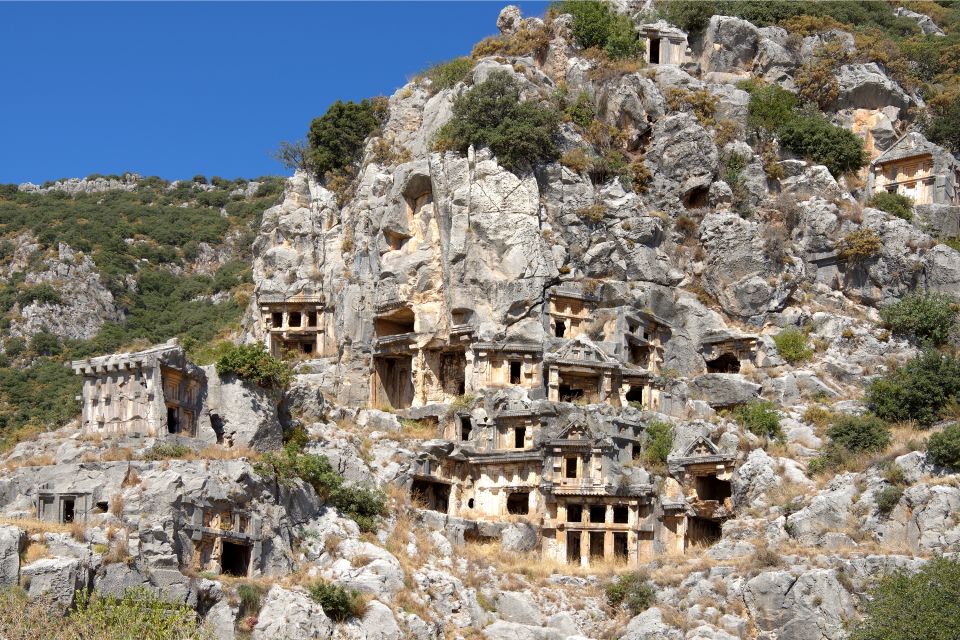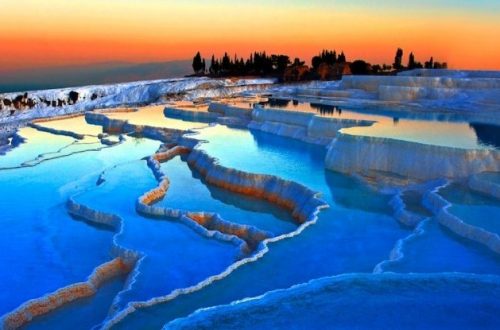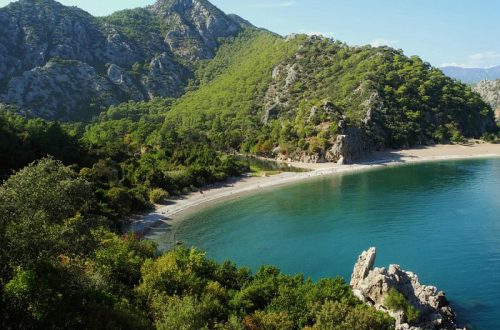
Reasons to see the ruins of Myra
The most famous resident of the ancient city of Myra is Saint Nicholas of Myra.
He is known as St. Nicholas, Santa Claus, Grandfather Frost or “St. Nicholas”.
It all depending on what you want to call him.
The most famous sights of Myra is the Church of the Holy Sepulchre of Nicholas, which was built for the bishop who lived in the 4th century AD.
In it you can become familiar with his life story and visit his sarcophagus.
Together with the archaeological treasures of the Lycian-Roman city of Myra, you have an excursion full of discoveries ahead of you.
Ruins of the Lycian – Roman city
The ruins of Myra are located in the Turkish province of Antalya. The county town of Demre has grown around the archaeological site in recent years.
Myra held certain importance during the Age of Greek Hellenism. There are some written traditions by the Greeks during this time.
The city experienced its first rise to prominence as a member of the Lycian League. It was an amalgamation of several cities on the central south coast of Turkey. Other well-known ruins are Olympos, Phaselis and the UNSESCO World Heritage City of Xanthos.
Before Christianity was adopted by the Roman Empire, the goddess Artemis Eleuthera (Cybele) had a large following in the city. Her temple is said to have been the largest and most magnificent on the entire Lycian coast.
According to historical sources, the temple collapsed in an earthquake in 141. Parts of the amphitheatre were also badly damaged by the earthquake. In contrast to the temple, it has been rebuilt. According to legend, the Temple of Artemis is said to have been destroyed by Nicholas. This actually does not make sense, since he was born at the end of the 4th century.
Myra took on an important role towards the end of the Roman Empire. The Lycia region was separated from Pamphylia by Emperor Theodorus and made into an independent province. The administrative headquarters became Myra.
After the sacking of Myra by Arab troops in 809, the town fell into decline, losing its importance. In the following years there were attacks by the Seljuks, who were able to bring Myra under their control for a long time. Merchants from Bari took advantage of the chaotic situation. They stole the bones of Nicholas and brought them back to their hometown along the coast of Italy.
Over the centuries, the ruins of the city have been buried by the mud of the Demre River. Only excavations in 1965 and 1968 have uncovered large portions of Myra.
Visit the excavation facilities
Much of Myra has yet to be excavated. Therefore the visible part of the ruins is not too big.
You should still give yourself plenty of time for the many small details on the wall and buildings. The houses, columns and graves have all been designed with great attention to detail.
They are all covered with rich decorations. They show images from mythology, history and everyday life. There is something to discover almost everywhere.
For example, on a stone slab you can see the head of Medusa with the snakes. Guides can show and explain many more hidden details of the ruins to you. It really pays off to take a guided tour.
Sitting in the theatre, you can let your gaze wander over the ruins and the modern Demre in the background.
What you will see are many greenhouses where citrus fruits and tomatoes are grown. They are the main source of income for the locals in this region.
Ruins of Simena : information
The ruins are currently open every day, all year round.
Entry currently costs 15 Turkish Lira.
You can combine a trip to Myra with a visit to the Church of St. Nicholas and the ancient port of Andriake.
Excursions are offered by local tour operators from all the surrounding tourist locations. If you come from Antalya, they almost always include a stop at the ruins of a city on the island of Kekova that has been submerged in the sea for 1,000 years.
As with all the popular tourist attractions in Turkey, there are of course stalls with souvenirs, clothing and all sorts of useful and useless items at Myra.
Visiting the ruins
Apart from the Basilica of St. Nicholas, the Lycian stone tombs are particularly interesting.
The ruins are located at the foot of a hill, which is surrounded in the south by the small town of Demre.
The result is a picture of the old graves, the theatre and dozens of greenhouses that have been built over the surrounding area.
Roman theatre
As is customary in the Lycia region, the theatre was built on a hill. The rows of seats have been well preserved in terms of their shape and appearance. Unfortunately, only the foundation walls of the partial area behind the stage have been preserved.
Lycian rock tombs
The rock tombs are a peculiarity of the ancient Lycian culture. The tombs were driven into the rock like small houses. You can find them on a small hill and a rocky cliff near the ruins. Only the richest inhabitants of the city were buried in these types of graves. Ordinary citizens could not afford such an expensive burial site.
Together with their sarcophagi and the rest of the necropolis, they are among the most impressive sights of Myra. Besides Myra, there are only such similarly well-preserved rock tombs near Fethiye.
Andriake harbour
Andriakes was Myra’s access to the lake. It is about 5 kilometres south of the ruins. The port facilities experienced their heyday in the early Byzantine Empire. At that time, several churches and baths were constructed that can still be seen today. The merchandise of that time included a commodity that was more valuable than gold. It is the purple dye made from the purple snail. It was obtained directly from the port facilities in their own buildings. Waste residues still testify to the extraction of the valuable purple hued dye.
Adjacent is a large granary that is still very well preserved.
After writing about Nikolaus of Myra, a few other mentions fit into the article. Andriakes port was a place where the apostle Paul changed ships on his way to Rome.
Saint Nicholas Basilica
The basilica is known as the burial place of Nicholas of Myra. He lived in the 4th century and was a bishop of the Orthodox Church. He is an important figure of faith in both Catholic and Orthodox Christianity.
First mentions of a basilica go back to the 6th century. But that cannot be said with certainty as it has been renewed several times.
What is certain is that the core of its current form dates back to the 8th century. The pilgrimage site was expanded to include a monastery in the 11th century. The monks living there maintained of the basilica from that point on.
In 1087, the bones of Nicholas were stolen by sea traders from Bari during a trip to Jerusalem. They brought them back to their hometown. This made the Italian city one of the centres of the cult of St. Nicholas.
The basilica fell into oblivion after Anatolia was conquered by Arabs, it later the Seljuks and finally the Ottomans. It was partially buried under the mud of the Demre River. The last time it was said to be used by the city’s residents was sometime during the 12th century.
Tsar Alexander II of Russia purchased the ruins in 1863 and had them partially restored. Overall, the basilica is visited by a large number of Russian tourists and pilgrims. This is due to the importance of Nicholas in the Greek and Russian Orthodox Churches. Apparently, it takes on a greater meaning than in the Catholic or Protestant doctrines of the Christian faith.
The western and eastern sections became exposed during archaeological work in 1963. It is protected from erosion from wind and weather by a newly built wooden roof.
A tour of the church will not take you very long. After an hour, you will have seen everything inside.
The frescoes in the interior are particularly interesting. They are very well preserved. Beautiful paintings can be seen, especially under the Byzantine dome roof and round arches.
A modern Nicholas monument in front of the entrance refers to the most famous inhabitant of Myra, who lived over 1,500 years ago.
There are some old sarcophagi in the church. Some date from the time of the Romans. They were reused in the construction of the basilica.
Outside there are souvenir stalls selling religious mementos.
The life of Nikolaus von Myra
The Catholic Church knows Nicholas as a benefactor and “saint” who brings presents to young children on December 6th. In the Russian Orthodox Church, Nicholas also gives presents to children. However, in Russia he also bears the name “Grandfather Frost”. He brings the presents on New Year’s Eve. He takes on the role played by Santa Claus.
Historical sources report that Nicholas was born in the Lycian port city of Patara. His year of birth is estimated at between 280 and 286 AD. Unfortunately, there is no more precise information. He lived in Patara until he became the Bishop of Myra.
He gained fame as a protector of children, young people, travellers, the poor and seafarers. Even during his lifetime, miracles that Nikolaus is said to have worked for his protégés were the focal point of many stories.
Nikolaus spent the majority of his long life in Myra. After his death he was “canonized” by the Church. Nicholas later became the patron saint of Greece and Russia.
The anniversary of his death on December 6th is celebrated by Christians around the world as Saint Nicholas Day. The year of his death is estimated between 345 and 351.
The sarcophagus of Nicholas was broken into in 1087 by traveling salesmen from Bari. They took his bones with them to their hometown in southeast Italy. They arrived there with them on May 9, 1087. Since then, Bari has been one of the most important pilgrimage sites for the cult of St. Nicholas.
During the Byzantine Empire and the centuries that followed, Nicholas became one of the most beloved saints of Christians everywhere. Many churches were consecrated in his name. This was particularly true in port cities that were inhabited by Christian seafarers.
Nicholas has a special place among Christians in Greece, Russia, Freiburg, Bari, Naples and Sicily.
Today he is less known as a historical figure but has been defined by what legends and stories say about him. In the countries around the world he has taken on different names: Santa Claus, Grandfather Frost, and “Saint Nicholas”.
They are united by similar properties. All figures are based on Nicholas, a bearded figure that brings gifts to young children. He is also known for ensuring justice, as only good children receive nice gifts.
Myra
There are so many archaeological sites to visit on the south coast between Kemer and Fethiye. It’s hard to decide which is the most interesting. Myra is definitely one of the “must-see” sights, but I personally happen to like Olympos and Phaselis better.
Olympos has its own charm with its ruins overgrown by trees and bushes. It’s almost a little mystical. You can also go to the beach in just a few minutes and relax there. The same goes for Phaselis.
Myra is definitely a worthwhile destination if you want to see old Lycian stone graves. They only exist on this part of the coast. In addition, in my opinion, Myra’s graves, along with those in Fethiye, are among the most beautiful.
In addition, of course, there is the most famous resident of the city, Nikolaus of Myra. He’s a big star, at least with children. Although he less and less known by his original name, Santa Claus is increasingly more popular.
What are your impressions of Myra and Nikolaus?




